Progress in Improving Safety Performance of Battery Separators Based on MOF Materials: Mechanisms, Materials and Applications
Abstract
1. Introduction
2. Mechanisms for Improving Safety Performance Based on MOF Separators
2.1. Dendrite Inhibition Capability
2.2. Thermal Stability
2.3. Mechanical Robustness
3. MOF as a Form and Strategy for Separators
3.1. Pure MOF Diaphragms
3.2. MOF Separator Materials
3.3. Functional Modification of MOF Separator Materials
4. MOF Separator Design for Safety-Critical Battery Systems
4.1. Lithium-Ion Battery (LIB)
4.2. Lithium–Sulfur Batteries (Li-S)
4.3. Aqueous Zinc-Ion Batteries (AZIBs)
4.4. Solid-State Lithium Metal Batteries
5. Scalability and Manufacturing Challenges
5.1. Advanced Manufacturing Technology
5.2. Cost–Safety Trade-Offs
6. Conclusions and Views
Author Contributions
Funding
Institutional Review Board Statement
Informed Consent Statement
Data Availability Statement
Conflicts of Interest
References
- Liu, Y.; Li, Q.; Wang, Z. Recent progress about transmission electron microscopy characterizations on lithium-ion batteries. J. Energy Chem. 2024, 95, 39–56. [Google Scholar] [CrossRef]
- Zhang, D.; Wang, W.; Li, S.; Shen, X.; Xu, H. Design strategies and energy storage mechanisms of MOF-based aqueous zinc ion battery cathode materials. Energy Storage Mater. 2024, 69, 103436. [Google Scholar] [CrossRef]
- Zhao, T.; Chen, J.; Xiao, P.; Nie, S.; Luo, F.; Chen, Y. Exploring metal-organic frameworks in battery electrodes, separators, and electrolytes: A comprehensive review. Coord. Chem. Rev. 2025, 532, 216501. [Google Scholar] [CrossRef]
- Song, Y.; Sheng, L.; Wang, L.; Xu, H.; He, X. From separator to membrane: Separators can function more in lithium ion batteries. Electrochem. Commun. 2021, 124, 106948. [Google Scholar] [CrossRef]
- Xue, Y.; Li, W.; Liu, R.; Lv, Y.; Li, J.; Li, D.; Guo, Y.; Hao, R.; He, H. Functionalized separator strategies accelerate the development of Zinc-Ion batteries. iScience 2025, 28, 112787. [Google Scholar] [CrossRef] [PubMed]
- Du, F.; Wu, F.; Ma, L.; Feng, J.; Yin, X.; Wang, Y.; Dai, X.; Liu, W.; Shi, W.; Cao, X. A review on advanced optimization strategies of separators for aqueous zinc-ion batteries. Funct. Mater. Lett. 2023, 16, 2340017. [Google Scholar] [CrossRef]
- Zong, Y.; He, H.; Wang, Y.; Wu, M.; Ren, X.; Bai, Z.; Wang, N.; Ning, X.; Dou, S.X. Functionalized separator strategies toward advanced aqueous Zinc-ion batteries. Adv. Energy Mater. 2023, 13, 2300403. [Google Scholar] [CrossRef]
- Li, L.; Jia, S.; Zhang, C.C. Improved strategies for separators in Zinc-ion batteries. ChemSusChem 2023, 16, e202202330. [Google Scholar] [CrossRef] [PubMed]
- Ma, X.; Cheng, Z.; Zhang, T.; Zhang, X.; Ma, Y.; Guo, Y.; Wang, X.; Zheng, Z.; Hou, Z.; Zi, Z. High efficient recycling of glass fiber separator for sodium-ion batteries. Ceram. Int. 2023, 49, 23598–23604. [Google Scholar] [CrossRef]
- Ma, X.; Chen, Z.; Zhang, T.; Zhang, X.; Ma, Y.; Guo, Y.; Wei, Y.; Ge, M.; Hou, Z.; Zi, Z. Efficient utilization of glass fiber separator for low-cost sodium-ion batteries. Int. J. Miner. Metall. Mater. 2023, 30, 1878–1886. [Google Scholar] [CrossRef]
- Chen, H.; Wang, Z.; Feng, Y.; Cai, S.; Gao, H.; Wei, Z.; Zhao, Y. Cellulose-based separators for lithium batteries: Source, preparation and performance. Chem. Eng. J. 2023, 471, 144593. [Google Scholar] [CrossRef]
- Liu, W.; Dang, Y.; Xie, W.; Tang, A. Weakening of mechanical properties of cellulose separator caused by electrolyte immersion and elevated temperature. Polym. Compos. 2019, 40, 3857–3865. [Google Scholar] [CrossRef]
- Jiang, Y.; Sun, C.; Dong, F.; Xie, H.; Sun, L. Multilayer polyethylene separator with enhanced thermal properties for safe lithium-ion batteries. Particuology 2024, 91, 29–37. [Google Scholar] [CrossRef]
- Man, Y.; Nan, H.; Ma, J.; Li, Z.; Zhou, J.; Wang, X.; Li, H.; Xue, C.; Yang, Y. Functionalized γ-boehmite covalent grafting modified polyethylene for lithium-ion battery separator. Materials 2024, 17, 2162. [Google Scholar] [CrossRef] [PubMed]
- Yu, Y.; Liu, M.; Chen, Z.; Zhang, Z.; Qiu, T.; Hu, Z.; Xiang, H.; Zhu, L.; Xu, G.; Zhu, M. Advances in nonwoven-based separators for lithium-ion batteries. Adv. Fiber Mater. 2023, 5, 1827–1851. [Google Scholar] [CrossRef]
- Tong, B.; Li, X. Towards separator safety of lithium-ion batteries: A review. Mater. Chem. Front. 2024, 8, 309–340. [Google Scholar] [CrossRef]
- Cheng, Z.; Lian, J.; Zhang, J.; Xiang, S.; Chen, B.; Zhang, Z. Pristine MOF materials for separator application in Lithium–Sulfur battery. Adv. Sci. 2024, 11, 2404834. [Google Scholar] [CrossRef] [PubMed]
- Phung, J.; Zhang, X.; Deng, W.; Li, G. An overview of MOF-based separators for lithium-sulfur batteries. Sustain. Mater. Technol. 2022, 31, e00374. [Google Scholar] [CrossRef]
- Gao, X.; Wang, L.; Cheng, J.; Zhao, J.; Liu, X. Manufacturing process of MOF-based separator for lithium sulfur batteries: A mini review. Chin. Chem. Lett. 2025, 36, 110247. [Google Scholar] [CrossRef]
- Yanilmaz, M.; Atik, A.; Tosun, M.; Zhang, X. MOF@ Nanofiber separators for Lithium-ion batteries. J. Appl. Polym. Sci. 2025, 142, e56562. [Google Scholar] [CrossRef]
- Jia, T.; Gu, Y.; Li, F. Progress and potential of metal-organic frameworks (MOFs) for gas storage and separation: A review. J. Environ. Chem. Eng. 2022, 10, 108300. [Google Scholar] [CrossRef]
- Felix Sahayaraj, A.; Joy Prabu, H.; Maniraj, J.; Kannan, M.; Bharathi, M.; Diwahar, P.; Salamon, J. Metal–Organic Frameworks (MOFs): The next generation of Materials for catalysis, gas storage, and separation. J. Inorg. Organomet. Polym. Mater. 2023, 33, 1757–1781. [Google Scholar] [CrossRef]
- Li, X.; Chen, K.; Guo, R.; Wei, Z. Ionic liquids functionalized MOFs for adsorption. Chem. Rev. 2023, 123, 10432–10467. [Google Scholar] [CrossRef]
- Wang, L.-B.; Wang, J.-J.; Yue, E.-L.; Li, J.-F.; Bai, C.; Tang, L.; Wang, X.; Hou, X.-Y.; Zhang, Y. Fluorescence sensing and anti-counterfeiting application based a heterometallic Cd (II)–Na (I)-MOF. J. Solid State Chem. 2022, 309, 123026. [Google Scholar] [CrossRef]
- Wang, Y.; Yan, J.; Wen, N.; Xiong, H.; Cai, S.; He, Q.; Hu, Y.; Peng, D.; Liu, Z.; Liu, Y. Metal-organic frameworks for stimuli-responsive drug delivery. Biomaterials 2020, 230, 119619. [Google Scholar] [CrossRef]
- Dai, Y.; Zhang, G.; Peng, Y.; Li, Y.; Chi, H.; Pang, H. Recent progress in 1D MOFs and their applications in energy and environmental fields. Adv. Colloid Interface Sci. 2023, 321, 103022. [Google Scholar] [CrossRef]
- Zhao, T.; Luo, F.; Xiao, P.; Nie, S.; Chen, J.; Chen, Y. Strategies for the preparation of MOFs-based composites and their research progress in electrocatalysis. Microporous Mesoporous Mater. 2025, 389, 113560. [Google Scholar] [CrossRef]
- Li, Z.; Wang, J.; Yuan, H.; Yu, Y.; Tan, Y. Recent progress and challenge in Metal–Organic Frameworks for Lithium–Sulfur battery separators. Adv. Funct. Mater. 2024, 34, 2405890. [Google Scholar] [CrossRef]
- Zhao, T.; Xiao, P.; Nie, S.; Luo, M.; Zou, M.; Chen, Y. Recent progress of Metal-Organic Frameworks based high performance batteries separators: A review. Coord. Chem. Rev. 2024, 502, 215592. [Google Scholar] [CrossRef]
- Zhao, T.; Nie, S.; Xiao, P.; Peng, S.; Chen, J.; Yu, J.; Luo, F.; Chen, Y. Exploring the influence of MIL-101(Cr) morphologies on the efficacy of cellulose separators for zinc ion battery performance. J. Membr. Sci. 2025, 720, 123788. [Google Scholar] [CrossRef]
- Huang, Q.; Zhao, C.; Li, X. Enhanced electrolyte retention capability of separator for lithium-ion battery constructed by decorating ZIF-67 on bacterial cellulose nanofiber. Cellulose 2021, 28, 3097–3112. [Google Scholar] [CrossRef]
- Tang, G.; Song, X.; Qiu, X.; Wang, J.; Sun, X.; Chen, F.; Cao, Z.; Gao, S. A ZIF-8 modified aramid nanofiber separator against the shuttle effect for high performance lithium-sulfur batteries. J. Alloys Compd. 2024, 971, 172698. [Google Scholar] [CrossRef]
- Han, G.; Hu, Q.; Xia, Y.; Gao, K.; Wang, Y.; Yao, J. Stabilizing dendrite-free lithium metal batteries via an anionphilic ZIF-67 modified separator. J. Alloys Compd. 2025, 1036, 181713. [Google Scholar] [CrossRef]
- Razaq, R.; Din, M.M.U.; Småbråten, D.R.; Eyupoglu, V.; Janakiram, S.; Sunde, T.O.; Allahgoli, N.; Rettenwander, D.; Deng, L. Synergistic effect of bimetallic MOF modified separator for long cycle life lithium-sulfur batteries. Adv. Energy Mater. 2024, 14, 2302897. [Google Scholar] [CrossRef]
- Zhang, J.; Zhang, Z.; Wu, T.; Luo, X. MOF particles (UiO-66 and UiO-66(Ce))/cellulose nanocomposite separators with regulating ion transport controllably for lithium battery. J. Electroanal. Chem. 2023, 946, 117708. [Google Scholar] [CrossRef]
- Fan, Y.; Niu, Z.; Zhang, F.; Zhang, R.; Zhao, Y.; Lu, G. Suppressing the Shuttle Effect in Lithium–Sulfur Batteries by a UiO-66-Modified Polypropylene Separator. ACS Omega 2019, 4, 10328–10335. [Google Scholar] [CrossRef] [PubMed]
- Jia, S.; Chen, Z.; Li, Y.; Li, C.; Duan, C.; Lim, K.H.; Kawi, S. Construction of greenly biodegradable bacterial cellulose/UiO-66-NH2 composite separators for efficient enhancing performance of lithium-ion battery. Int. J. Biol. Macromol. 2024, 269, 131988. [Google Scholar] [CrossRef]
- Zhao, T.; Xiao, P.; Nie, S.; Yu, J.; Peng, S.; Chen, J.; Luo, F.; Chen, Y. Innovative bacterial cellulose and UiO-66 composites for superior zinc ion battery separator performance. Green Chem. 2025, 27, 9541–9558. [Google Scholar] [CrossRef]
- Sun, X.; Yu, X.; Zhou, Y.; Hu, Z.; Mao, W.; Ai, G.; Li, D. Biomimic membrane-like separator toward ultra-stable high-rate lithium metal anodes. J. Energy Storage 2025, 111, 115394. [Google Scholar] [CrossRef]
- Chen, C.; Zhang, W.; Zhu, H.; Li, B.-G.; Lu, Y.; Zhu, S. Fabrication of metal-organic framework-based nanofibrous separator via one-pot electrospinning strategy. Nano Res. 2021, 14, 1465–1470. [Google Scholar] [CrossRef]
- Sun, K.; Wu, H.; Huang, H.; Huang, X.; Xu, Y.; Xu, F. In-situ growth strategy to design metal-organic frameworks separators for efficient Zn-ion hybrid supercapacitors. Chem. Eng. J. 2025, 511, 162004. [Google Scholar] [CrossRef]
- Deng, N.; Wang, L.; Feng, Y.; Liu, M.; Li, Q.; Wang, G.; Zhang, L.; Kang, W.; Cheng, B.; Liu, Y. Co-based and Cu-based MOFs modified separators to strengthen the kinetics of redox reaction and inhibit lithium-dendrite for long-life lithium-sulfur batteries. Chem. Eng. J. 2020, 388, 124241. [Google Scholar] [CrossRef]
- Wang, S.; Yu, Y.; Fu, S.; Li, H.; Huang, J. Regulating the non-effective carriers transport for high-performance lithium metal batteries. J. Energy Chem. 2024, 92, 132–141. [Google Scholar] [CrossRef]
- Jia, S.; Li, Y.; Chen, Z.; Li, C.; Duan, C.; Shen, B. Synthesis of PMIA/MIL-101(Cr) composite separators with high Li+ transmission for boosting safety and electrochemical performance of lithium-ion batteries. J. Colloid Interface Sci. 2023, 647, 12–22. [Google Scholar] [CrossRef] [PubMed]
- Cheng, H.; Tan, R.; Li, J.; Huang, J.; Song, W. Coatings on Lithium battery separators: A Strategy to Inhibit Lithium Dendrites Growth. Molecules 2023, 28, 7788. [Google Scholar] [CrossRef]
- Wang, C.; Hao, Z.; Hu, Y.; Wu, Y.; Liu, J.; Jin, Y.; Wang, H.; Zhang, Q. Enabling dendrite-free and high-rate lithium anode with a self-standing anionic-MOF separator. J. Mater. Chem. A 2023, 11, 8131–8140. [Google Scholar] [CrossRef]
- Cheng, N.-C.; Wu, Y.C.; Chu, Y.-C.; Hsu, H.-Y.; Chen, W.-C.; Wang, P.-H.; Chang, T.-L.; Chang, J.-K.; Wang, C.-Y. A modulated MOF as a modification layer on copper foil for lithium dendrite suppression. J. Mater. Chem. A 2024, 12, 8474–8486. [Google Scholar] [CrossRef]
- Deng, L.; Cai, C.; Huang, Y.; Fu, Y. In-situ MOFs coating on 3D-channeled separator with superior electrolyte uptake capacity for ultrahigh cycle stability and dendrite-inhibited lithium-ion batteries. Microporous Mesoporous Mater. 2022, 329, 111544. [Google Scholar] [CrossRef]
- Ma, H.; Yu, J.; Chen, M.; Han, X.; Chen, J.; Liu, B.; Shi, S. Amino-enabled desolvation sieving effect realizes dendrite-inhibiting thin separator for durable aqueous Zinc-ion batteries. Adv. Funct. Mater. 2023, 33, 2307384. [Google Scholar] [CrossRef]
- Cai, K.; Liu, Y.; Lang, X.; Li, L.; Zhang, Q.; Xu, T.; Chen, D. Design of cobalt-based metal-organic frameworks like solid electrolyte interphase (SEI) film for chemically stable graphite anode of lithium-ion batteries. Ionics 2020, 26, 61–67. [Google Scholar] [CrossRef]
- Liu, Y.; Liu, Q.; Hong, Y.; Xu, Y.; Chen, Z.; Zhao, W.; Hu, Z.; Wang, J.; Wu, H.B. Solvent sieving separators implement dual electrolyte for high-voltage lithium-metal batteries. Nano Res. 2023, 16, 4901–4907. [Google Scholar] [CrossRef]
- Huo, H.; Li, X.; Chen, Y.; Liang, J.; Deng, S.; Gao, X.; Doyle-Davis, K.; Li, R.; Guo, X.; Shen, Y.; et al. Bifunctional composite separator with a solid-state-battery strategy for dendrite-free lithium metal batteries. Energy Storage Mater. 2020, 29, 361–366. [Google Scholar] [CrossRef]
- Ren, W.; Liang, J.; Huang, M.; Qian, W.; Zhao, M.; Qiao, F.; Cui, L.; Zhang, Z.; Wang, J.; Zhou, C.; et al. Thermally-stable and flame-retardant metal-organic framework-based separator for high-performance lithium-ion batteries. Chem. Eng. J. 2024, 498, 155811. [Google Scholar] [CrossRef]
- Huang, D.; Liang, C.; Chen, L.; Tang, M.; Zheng, Z.; Wang, Z. MOF composite fibrous separators for high-rate lithium-ion batteries. J. Mater. Sci. 2021, 56, 5868–5877. [Google Scholar] [CrossRef]
- Song, X.; Huang, W.; Wang, H.; Lu, Y.M.; Xing, J. Polyimide/Metal–Organic Framework-5 separator with excellent electrolyte wettability and thermal stability for high performance Lithium-ion battery. ACS Appl. Polym. Mater. 2025, 7, 6312–6325. [Google Scholar] [CrossRef]
- Zhou, L.; Pan, H.; Yin, G.; Xiang, Y.; Tan, P.; Li, X.; Jiang, Y.; Xu, M.; Zhang, X. Tailoring the function of battery separators via the design of MOF coatings. Adv. Funct. Mater. 2024, 34, 2314246. [Google Scholar] [CrossRef]
- Leng, X.; Zeng, J.; Yang, M.; Li, C.; Vattikuti, S.V.P.; Chen, J.; Li, S.; Shim, J.; Guo, T.; Ko, T.J. Bimetallic Ni–Co MOF@PAN modified electrospun separator enhances high-performance lithium-sulfur batteries. J. Energy Chem. 2023, 82, 484–496. [Google Scholar] [CrossRef]
- Qi, J.; Zhang, M.; Xu, T.; Liu, K.; Wang, Y.; Zhang, H.; Wang, X.; Yuan, Z.; Si, C. Nanocellulose/metal-organic frameworks composites for advanced energy storage of electrodes and separators. Chem. Eng. J. 2024, 500, 157318. [Google Scholar] [CrossRef]
- Li, Y.; Peng, X.; Li, X.; Duan, H.; Xie, S.; Dong, L.; Kang, F. Functional Ultrathin Separators Proactively Stabilizing Zinc Anodes for Zinc-Based Energy Storage. Adv. Mater. 2023, 35, 2300019. [Google Scholar] [CrossRef] [PubMed]
- Tian, M.; Pei, F.; Yao, M.; Fu, Z.; Lin, L.; Wu, G.; Xu, G.; Kitagawa, H.; Fang, X. Ultrathin MOF nanosheet assembled highly oriented microporous membrane as an interlayer for lithium-sulfur batteries. Energy Storage Mater. 2019, 21, 14–21. [Google Scholar] [CrossRef]
- Lan, F.; Zhao, H.; Jiang, Y.; Jin, C.; Zhao, G.; Li, L. A thermomechanically stable nanofiber separator with multiscale MOF networks towards high-efficiency ion transport. J. Mater. Chem. A 2025, 13, 7357–7370. [Google Scholar] [CrossRef]
- Gao, K.; Luo, J.; Li, X.; Fan, K.; Luo, L.; Liu, X. Electrospun heterocycle aramid nanofiber separator with MOF-supported porous structure enabled excellent cycling stability for lithium metal batteries with high LiFePO4 loading. J. Alloys Compd. 2023, 966, 171549. [Google Scholar] [CrossRef]
- Kong, L.; Cheng, M.; Huang, H.; Pang, J.; Liu, S.; Xu, Y.; Bu, X.-H. Metal-organic frameworks for advanced aqueous ion batteries and supercapacitors. EnergyChem 2022, 4, 100090. [Google Scholar] [CrossRef]
- Peng, Y.; Xu, J.; Ma, J.; Bai, Y.; Cao, S.; Zhang, S.; Pang, H. Metal-organic framework (MOF) composites as promising materials for energy storage applications. Adv. Colloid Interface Sci. 2022, 307, 102732. [Google Scholar] [CrossRef]
- Yuan, N.; Sun, W.; Yang, J.; Gong, X.; Liu, R. Multifunctional MOF-based separator materials for advanced Lithium–Sulfur batteries. Adv. Mater. Interfaces 2021, 8, 2001941. [Google Scholar] [CrossRef]
- Wu, J.; Ma, Y.; Zhang, H.; Xie, H.; Hu, J.; Shi, C.; Chen, B.; He, C.; Zhao, N. Regulating metal centers of MOF-74 promotes PEO-based electrolytes for all-solid-state Lithium-metal batteries. ACS Appl. Mater. Interfaces 2024, 16, 16351–16362. [Google Scholar] [CrossRef]
- Ngo, N.M.; Nguyen, M.H.; Song, S.-W.; Park, S. Bimetallic metal organic Framework-modified glass fiber as composite separator for lithium sulfur batteries. Mater. Lett. 2025, 382, 137835. [Google Scholar] [CrossRef]
- Xu, S.; Liu, C.; Yang, Y.; Yao, Y.; Yang, H.; Rui, X.; Yu, Y. ZIF-8 functionalized separator regulating Na-ion flux and enabling high-performance sodium-metal batteries. Small Methods 2025, 9, 2402084. [Google Scholar] [CrossRef] [PubMed]
- Samy, A.; Palani, R.; Wu, Y.-S.; Wu, S.-H.; Chang, J.-K.; Numan, A.; Jose, R.; Yang, C.-C. Suppressing the redox shuttling effect based on the anion trapping composite separator enhances the performance of Li-O2 batteries. ACS Appl. Energy Mater. 2025, 8, 6407–6422. [Google Scholar] [CrossRef]
- Liu, T.; Hu, X.; Zhang, Y.; He, T.; Zhou, J.; Qiao, J. Ion transport regulated Lithium metal batteries achieved by electrospun ZIF/PAN composite separator with suitable electrolyte wettability. Batteries 2023, 9, 166. [Google Scholar] [CrossRef]
- Lin, S.; Dong, J.; Chen, R.; Zhang, G.; Huang, T.; Li, J.; Zhou, H.; Chung, L.-H.; Hu, X.; He, J. Lithium sulfonate-rich MOF modified separator enables high performance lithium–sulfur batteries. J. Alloys Compd. 2023, 965, 171389. [Google Scholar] [CrossRef]
- Yu, M.; Li, J.; Li, Z.; Mu, J.; Si, W.; Li, T.; Zheng, W.; Dai, Y.; Li, X.; He, G. Regulating Zn2+ flux and transport behavior with CF3-functionalized UiO-66 modified separator for high-performance aqueous zinc-ion batteries. J. Colloid Interface Sci. 2025, 701, 138636. [Google Scholar] [CrossRef]
- Pang, S.; Liu, Y.; Zhang, Z.; Li, Y.; Li, C.; Shi, Z.; Feng, S. Sulfonic acid functionalized Al-based MIL-101-NH2 modified separator for lithium-sulfur batteries. Microporous Mesoporous Mater. 2024, 365, 112892. [Google Scholar] [CrossRef]
- Cheng, X.-B.; Zhang, R.; Zhao, C.-Z.; Zhang, Q. Toward Safe Lithium Metal Anode in Rechargeable Batteries: A Review. Chem. Rev. 2017, 117, 10403–10473. [Google Scholar] [CrossRef] [PubMed]
- Yuan, H.; Ding, X.; Liu, T.; Nai, J.; Wang, Y.; Liu, Y.; Liu, C.; Tao, X. A review of concepts and contributions in lithium metal anode development. Mater. Today 2022, 53, 173–196. [Google Scholar] [CrossRef]
- Li, S.; Sun, L.; Gao, H.; Long, Y.; Guo, S.; Jia, Q.; Jiang, Y.; Ye, Z. Direct epitaxial growth of MOF arrays on Cu foils to regulate Li deposition toward lean-lithium metal batteries. Chem. Eng. J. 2025, 512, 162370. [Google Scholar] [CrossRef]
- Mei, S.; Liu, T.; Chen, L.; Wang, Y. Preparation and performance of a PU/PAN Lithium-ion battery separator based on a centrifugal spinning method. Appl. Sci. 2023, 13, 6682. [Google Scholar] [CrossRef]
- Du, M.; He, Z.; Zhang, Y.; Cai, Y.-P.; Zheng, Q. Sustainable release of LiNO3 from a fluorine-decorated Metal–Organic Framework separator to enable high-performance Li-metal batteries in carbonate electrolytes. Adv. Energy Mater. 2025, 15, 2403674. [Google Scholar] [CrossRef]
- Liu, C.; Li, W.; Wang, Z.; Jin, Z.; Deng, T.; Yang, Z.; Han, D.; Su, Y.; Wang, Y.; Cao, Z.; et al. Crystal facet-engineered anion regulation enables fast-charging stability in Lithium metal batteries. Angew. Chem. Int. Ed. 2025, 64, e202512742. [Google Scholar] [CrossRef]
- Yan, C.; Zhang, X.-Q.; Huang, J.-Q.; Liu, Q.; Zhang, Q. Lithium-anode protection in Lithium–Sulfur batteries. Trends Chem. 2019, 1, 693–704. [Google Scholar] [CrossRef]
- Yin, Y.-X.; Xin, S.; Guo, Y.-G.; Wan, L.-J. Lithium–Sulfur batteries: Electrochemistry, materials, and prospects. Angew. Chem. Int. Ed. 2013, 52, 13186–13200. [Google Scholar] [CrossRef]
- Su, Y.; Wang, W.; Wang, A.; Huang, Y.; Guan, Y. Cerium-Based MOF as a separator coating for high-performance Lithium-Sulfur batteries. J. Electrochem. Soc. 2022, 169, 030528. [Google Scholar] [CrossRef]
- Deng, N.; Kang, W.; Liu, Y.; Ju, J.; Wu, D.; Li, L.; Hassan, B.S.; Cheng, B. A review on separators for lithiumsulfur battery: Progress and prospects. J. Power Sources 2016, 331, 132–155. [Google Scholar] [CrossRef]
- Vignesh, K.; Mathivanan, T.; Ganeshbabu, M.; Prasanna Naga Puneeth, N.; Ramkumar, B.; Lee, Y.S.; Kalai Selvan, R. Nature-inspired three-dimensional foam-like porous carbon surface modified separator for high-performance Li-S batteries. Carbon Trends 2025, 20, 100545. [Google Scholar] [CrossRef]
- Quan, K.; Zhang, J.; Lin, W.; Tong, Q.; Yan, R.; Ye, D.; Weng, J.; Zhu, M. Multiple dimensional engineering of MOF-related materials in separators for Lithium-Sulfur batteries: A Review. J. Electrochem. Soc. 2022, 169, 120519. [Google Scholar] [CrossRef]
- Xia, S.; Xu, X.; Wu, W.; Chen, Y.; Liu, L.; Wang, G.; Fu, L.; Zhang, Q.; Wang, T.; He, J.; et al. Advancements in functionalized high-performance separators for lithium-sulfur batteries. Mater. Sci. Eng. R Rep. 2025, 163, 100924. [Google Scholar] [CrossRef]
- Xiao, H.; Qin, J.; Wang, H.; Lai, X.; Shi, P.; Chen, C.; Sun, D. MOF-Derived CeO2 Nanorod as a Separator Coating Enabling Enhanced Performance for Lithium–Sulfur Batteries. Molecules 2024, 29, 1852. [Google Scholar] [CrossRef]
- Liang, F.; Zhu, Y.; Wang, N.; Zhu, M.; He, H.; Zhu, Y.; Shen, P.; Zhu, J. Recent advances in copper-based materials for robust lithium polysulfides adsorption and catalytic conversion. Chin. Chem. Lett. 2024, 35, 109461. [Google Scholar] [CrossRef]
- Wang, W.; Xi, K.; Li, B.; Li, H.; Liu, S.; Wang, J.; Zhao, H.; Li, H.; Abdelkader, A.M.; Gao, X.; et al. A sustainable multipurpose separator directed against the shuttle effect of polysulfides for high-performance Lithium–Sulfur batteries. Adv. Energy Mater. 2022, 12, 2200160. [Google Scholar] [CrossRef]
- Sun, X.; Zheng, J.; Yang, T.; Liu, Y.; Wu, X.; Xiao, J.; Cai, X.; Song, Y.; He, C. Regulating capture and conversion of polysulfides by BiOCl/PAN nanofibers separator to realize longevous lithium-sulfur batteries. J. Energy Storage 2025, 129, 117364. [Google Scholar] [CrossRef]
- Kang, X.; He, T.; Dang, H.; Li, X.; Wang, Y.; Zhu, F.; Ran, F. Designing amino functionalized Titanium-Organic Framework on separators toward sieving and redistribution of polysulfides in Lithium-Sulfur batteries. Nano-Micro Lett. 2025, 17, 277. [Google Scholar] [CrossRef] [PubMed]
- Cheng, Z.; Chen, Y.; Lian, J.; Chen, X.; Xiang, S.; Chen, B.; Zhang, Z. Interface engineering of MOF nanosheets for accelerated redox kinetics in Lithium-Sulfur batteries. Angew. Chem. Int. Ed. 2025, 64, e202421726. [Google Scholar] [CrossRef]
- Chen, Y.; Zhang, L.; Pan, H.; Zhang, J.; Xiang, S.; Cheng, Z.; Zhang, Z. Pore-space-partitioned MOF separator promotes high-sulfur-loading Li–S batteries with intensified rate capability and cycling life. J. Mater. Chem. A 2021, 9, 26929–26938. [Google Scholar] [CrossRef]
- Wang, Y.; Niu, R.; Chen, L.; Yang, Y.; Yu, H.; Qiu, X. Fabrication of MXene/MOF composite separators for high performance lithium-sulfur batteries. Chem. Eng. J. 2025, 512, 162305. [Google Scholar] [CrossRef]
- Zhang, X.; Shen, Q.; Lin, X.; Luo, C.; Shen, Y.; Huang, X. Ion-confinement effect for zinc anode of aqueous zinc ion batteries. J. Energy Storage 2023, 73, 109085. [Google Scholar] [CrossRef]
- Wu, B.; Wu, Y.; Lu, Z.; Zhang, J.; Han, N.; Wang, Y.; Li, X.-m.; Lin, M.; Zeng, L. A cation selective separator induced cathode protective layer and regulated zinc deposition for zinc ion batteries. J. Mater. Chem. A 2021, 9, 4734–4743. [Google Scholar] [CrossRef]
- Xiong, B.; Chen, R.; Zeng, F.; Kang, J.; Men, Y. Thermal shrinkage and microscopic shutdown mechanism of polypropylene separator for lithium-ion battery: In-situ ultra-small angle X-ray scattering study. J. Membr. Sci. 2018, 545, 213–220. [Google Scholar] [CrossRef]
- Liu, T.; Hong, J.; Wang, J.; Xu, Y.; Wang, Y. Uniform distribution of zinc ions achieved by functional supramolecules for stable zinc metal anode with long cycling lifespan. Energy Storage Mater. 2022, 45, 1074–1083. [Google Scholar] [CrossRef]
- Huang, J.-Q.; Chong, W.G.; Zhang, B. Tackling the challenges of aqueous Zn-ion batteries via functional separator design. J. Power Sources 2024, 594, 234036. [Google Scholar] [CrossRef]
- Mohamed, M.M.; Hussain, A.; Hardianto, Y.P.; Faheem, M.; Mirghni, A.A.; Helal, A.; Aziz, M.A. Synergistic Role of UiO-66 and UiO-67 MOF-Modified Glass Fiber Separators for Dendrite-Free and Long-Life Zinc-Ion Batteries. Asian J. Org. Chem. 2025, 14, e202500204. [Google Scholar] [CrossRef]
- Zhao, J.; Chen, Z.; Meng, Z.; Zhang, J.; Lv, W.; Guo, C.; Lv, Z.; Huang, S.; Yang, Y.; Liu, Z.; et al. Epitaxy Orientation and Kinetics Diagnosis for Zinc Electrodeposition. ACS Nano 2025, 19, 736–747. [Google Scholar] [CrossRef]
- Zhang, R.; Feng, Y.; Ni, Y.; Zhong, B.; Peng, M.; Sun, T.; Chen, S.; Wang, H.; Tao, Z.; Zhang, K. Bifunctional interphase with target-distributed desolvation sites and directionally depositional ion flux for sustainable zinc anode. Angew. Chem. Int. Ed. 2023, 62, e202304503. [Google Scholar] [CrossRef]
- Zhou, H.; Chen, R.; Jiang, Z.; Li, J.; Liang, H.; Chung, L.-H.; Hu, X.; He, J. Zn-thiocatecholate functionalized MOF modified separator stabilizing zinc anodes for long-life aqueous zinc-ion batteries. Chem. Commun. 2025, 61, 10808–10811. [Google Scholar] [CrossRef]
- Wang, L.; Chen, Z.; Liu, Y.; Li, Y.; Zhang, H.; He, X. Safety perceptions of solid-state lithium metal batteries. eTransportation 2023, 16, 100239. [Google Scholar] [CrossRef]
- Li, Y.; Yang, L.; Dong, R.; Zhang, T.; Yuan, J.; Liu, Y.; Liu, Y.; Sun, Y.; Zhong, B.; Chen, Y.; et al. A high strength asymmetric polymer–inorganic composite solid electrolyte for solid-state Li-ion batteries. Electrochim. Acta 2022, 404, 139701. [Google Scholar] [CrossRef]
- Fu, X.; Wei, Q.; Zheng, W.; Bai, H.; Liu, X.; Hao, S.; Lu, W. Plasticized composite electrolytes with mesoporous silica nanoparticle-reinforced PVDF–HFP for solid-state lithium–metal batteries. New J. Chem. 2025, 49, 14710–14717. [Google Scholar] [CrossRef]
- Li, J.; Ji, Y.; Song, H.; Chen, S.; Ding, S.; Zhang, B.; Yang, L.; Song, Y.; Pan, F. Insights into the interfacial degradation of high-voltage all-solid-state Lithium batteries. Nano-Micro Lett. 2022, 14, 191. [Google Scholar] [CrossRef]
- Wang, S.; Fang, R.; Li, Y.; Liu, Y.; Xin, C.; Richter, F.H.; Nan, C.-W. Interfacial challenges for all-solid-state batteries based on sulfide solid electrolytes. J. Mater. 2021, 7, 209–218. [Google Scholar] [CrossRef]
- Shi, X.; Pang, Y.; Wang, B.; Sun, H.; Wang, X.; Li, Y.; Yang, J.; Li, H.W.; Zheng, S. In situ forming LiF nanodecorated electrolyte/electrode interfaces for stable all-solid-state batteries. Mater. Today Nano 2020, 10, 100079. [Google Scholar] [CrossRef]
- Choi, W.; Ku, J.H.; Kim, Y.; Gwon, H.; Yoon, G.; Yu, D.; Kim, J.-S. Formulating interfacial impedances for designing high-energy and high-power all-solid-state battery cathodes. ACS Appl. Mater. Interfaces 2024, 16, 26066–26078. [Google Scholar] [CrossRef]
- Xiao, Y.; Wang, Y.; Bo, S.-H.; Kim, J.C.; Miara, L.J.; Ceder, G. Understanding interface stability in solid-state batteries. Nat. Rev. Mater. 2020, 5, 105–126. [Google Scholar] [CrossRef]
- Chen, J.; Zhu, G.; Xu, H.; Jiang, K.; Zhao, Y. A polymer-modified separator with lithiophilic nanocapsules for high-performance lithium metal batteries. J. Energy Storage 2025, 131, 117512. [Google Scholar] [CrossRef]
- Zhang, W.; Tu, Z.; Qian, J.; Choudhury, S.; Archer, L.A.; Lu, Y. Design Principles of Functional Polymer Separators for High-Energy, Metal-Based Batteries. Small 2018, 14, 1703001. [Google Scholar] [CrossRef]
- Yang, L.-Y.; Cao, J.-H.; Cai, B.-R.; Liang, T.; Wu, D.-Y. Electrospun MOF/PAN composite separator with superior electrochemical performances for high energy density lithium batteries. Electrochim. Acta 2021, 382, 138346. [Google Scholar] [CrossRef]
- Zhang, C.; Shen, L.; Shen, J.; Liu, F.; Chen, G.; Tao, R.; Ma, S.; Peng, Y.; Lu, Y. Anion-Sorbent Composite Separators for High-Rate Lithium-Ion Batteries. Adv. Mater. 2019, 31, 1808338. [Google Scholar] [CrossRef]
- Ju, Y.; Liu, H.; Chen, Y.; Sheng, J.; Zhai, Y.; Dong, B.; Cheng, R.; Zhou, Y.; Li, L. An ultrathin Zn-BDC MOF nanosheets functionalized polyacrylonitrile composite separator with anion immobilization and Li+ redistribution for dendrite-free Li metal battery. Compos. Commun. 2023, 37, 101449. [Google Scholar] [CrossRef]
- Liu, J.-j.; Huang, Y.-h.; Zhang, X.-j.; Ding, Y.-X.; Liu, H.; Gui, X.-F. MOF-silsesquioxane synergistic modified hybrid porous membrane for high-performance and high-safety lithium battery. Mater. Lett. 2024, 361, 136162. [Google Scholar] [CrossRef]
- Boukayouht, K.; Bazzi, L.; Daouli, A.; Maurin, G.; El Hankari, S. Ultrarapid and sustainable synthesis of trimetallic-based MOF (CrNiFe-MOF) from stainless steel and disodium terephthalate-derived PET wastes. ACS Appl. Mater. Interfaces 2024, 16, 2497–2508. [Google Scholar] [CrossRef]
- Suresh, P.; Shakina, J.; Pandian, M.S.; Tharmaraj, P.; John Jeya Kamaraj, J.J. Cost-effective bimetallic MOF electrocatalyst with dual-linker strategy for enhanced oxygen and hydrogen evolution reactions. Mater. Sci. Eng. B 2025, 321, 118510. [Google Scholar] [CrossRef]
- An, H.-T.; Zhang, X.; Dong, C.; Lu, M.-Y.; Li, R.; Xie, Y.; Xie, L.-H.; Li, J.-R. Seed-aided green synthesis of metal-organic frameworks in water. Green Chem. Eng. 2023, 4, 64–72. [Google Scholar] [CrossRef]
- Xiao, Y.; Chen, Y.; Hong, A.N.; Bu, X.; Feng, P. Solvent-free synthesis of multi-module pore-space-partitioned Metal-Organic Frameworks for gas separation. Angew. Chem. Int. Ed. 2023, 62, e202300721. [Google Scholar] [CrossRef] [PubMed]
- Yang, X.; Zhang, Q.; Liu, Y.; Nian, M.; Xie, M.; Xie, S.; Yang, Q.; Wang, S.; Wei, H.; Duan, J.; et al. Metal-Organic Framework nanoparticles with universal dispersibility through crown ether surface coordination for phase-transfer catalysis and separation membranes. Angew. Chem. Int. Ed. 2023, 62, e202303280. [Google Scholar] [CrossRef] [PubMed]
- Li, H.; Zhao, C.; Ying, Y.; Zhang, W. Improve MOF-801 dispersibility in PVA membranes by a pre-crosslinking strategy for enhanced pervaporation performance. J. Membr. Sci. 2023, 687, 122043. [Google Scholar] [CrossRef]

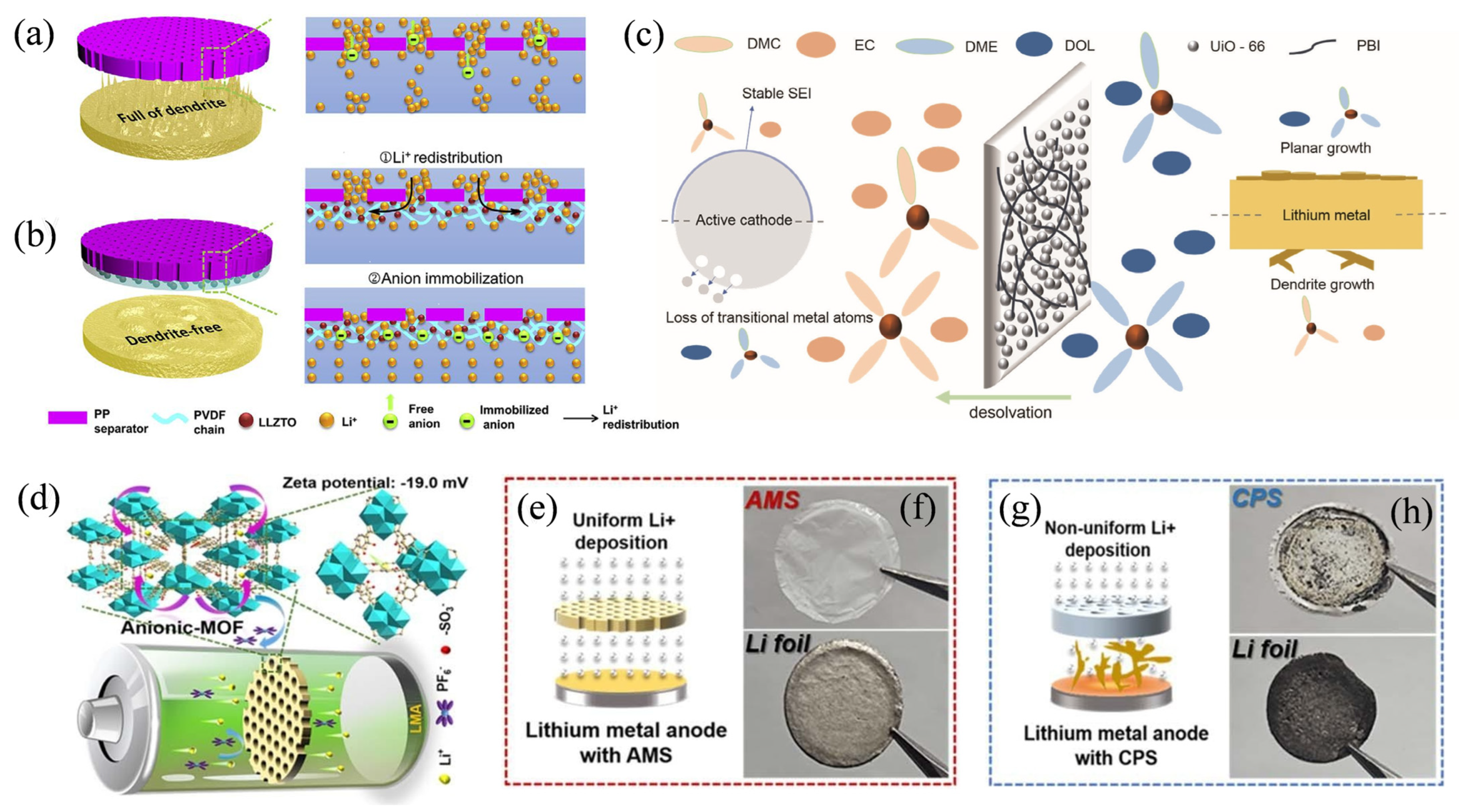
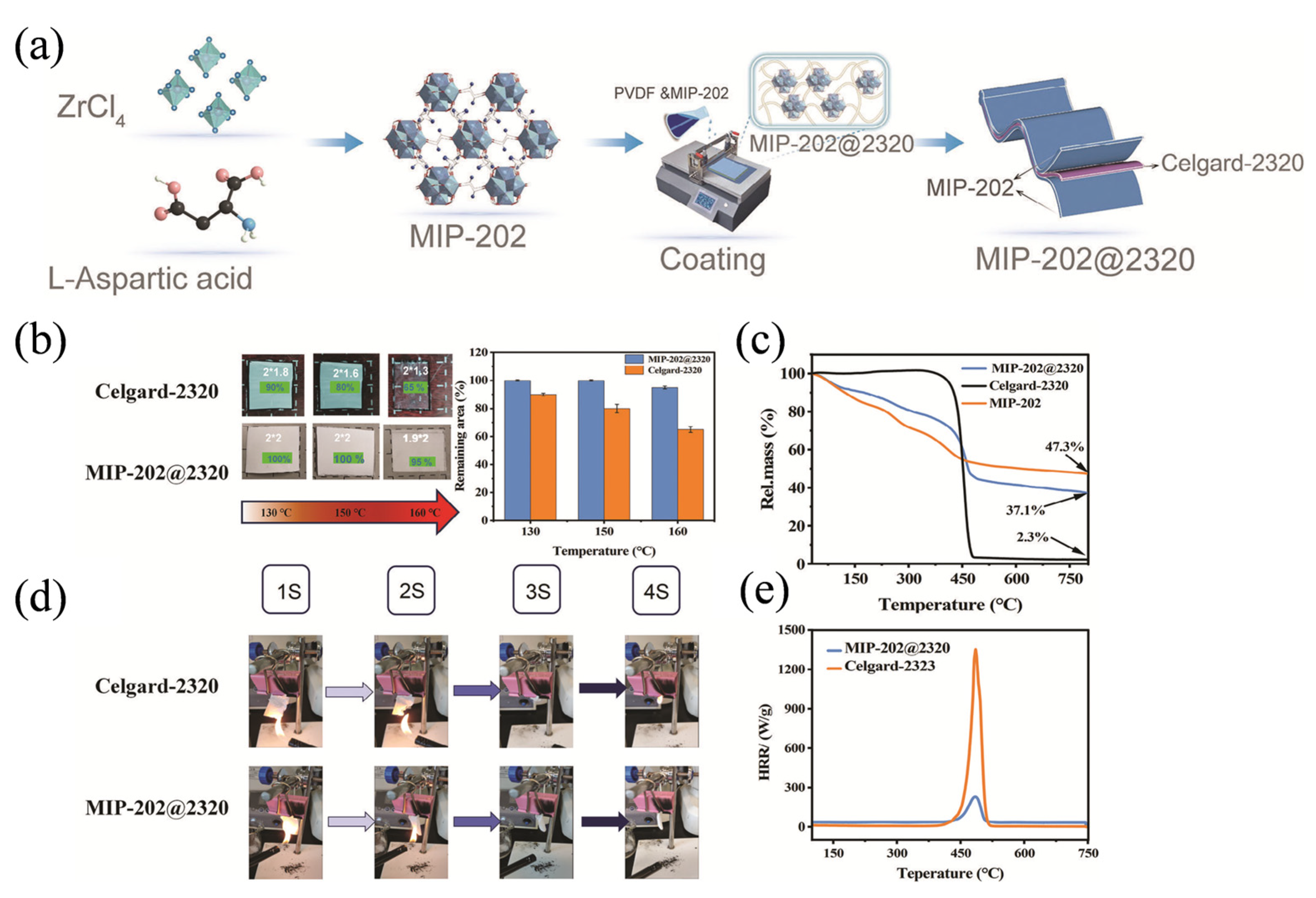



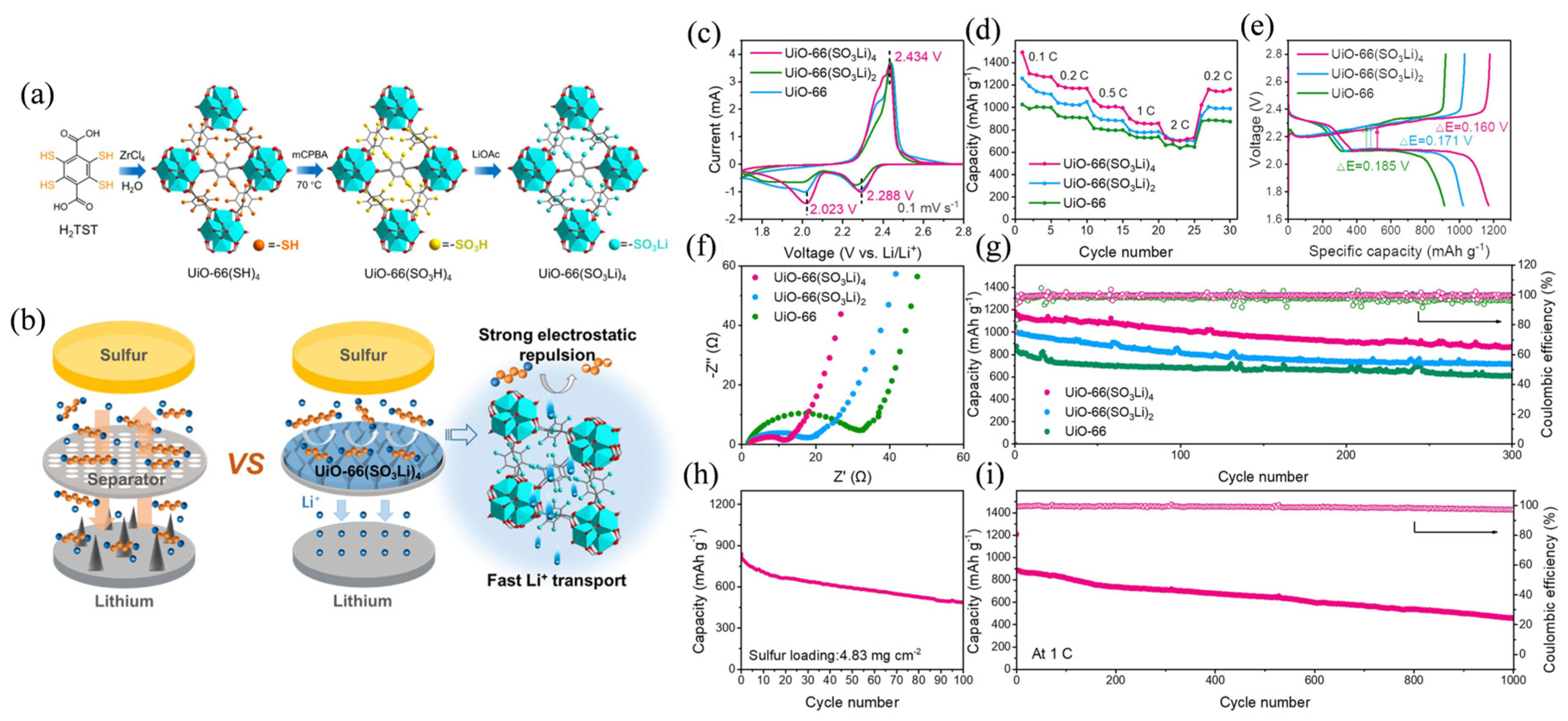
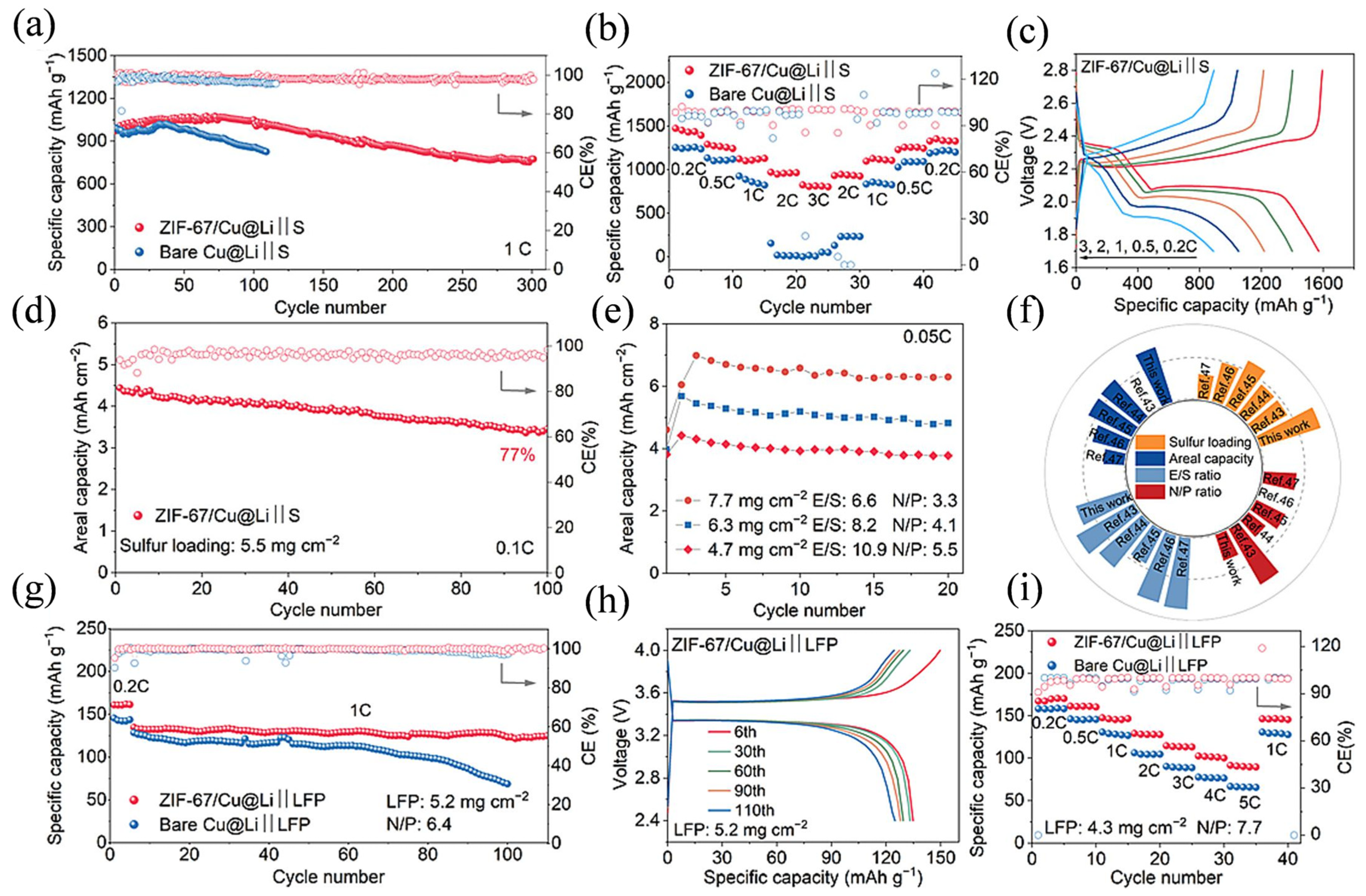

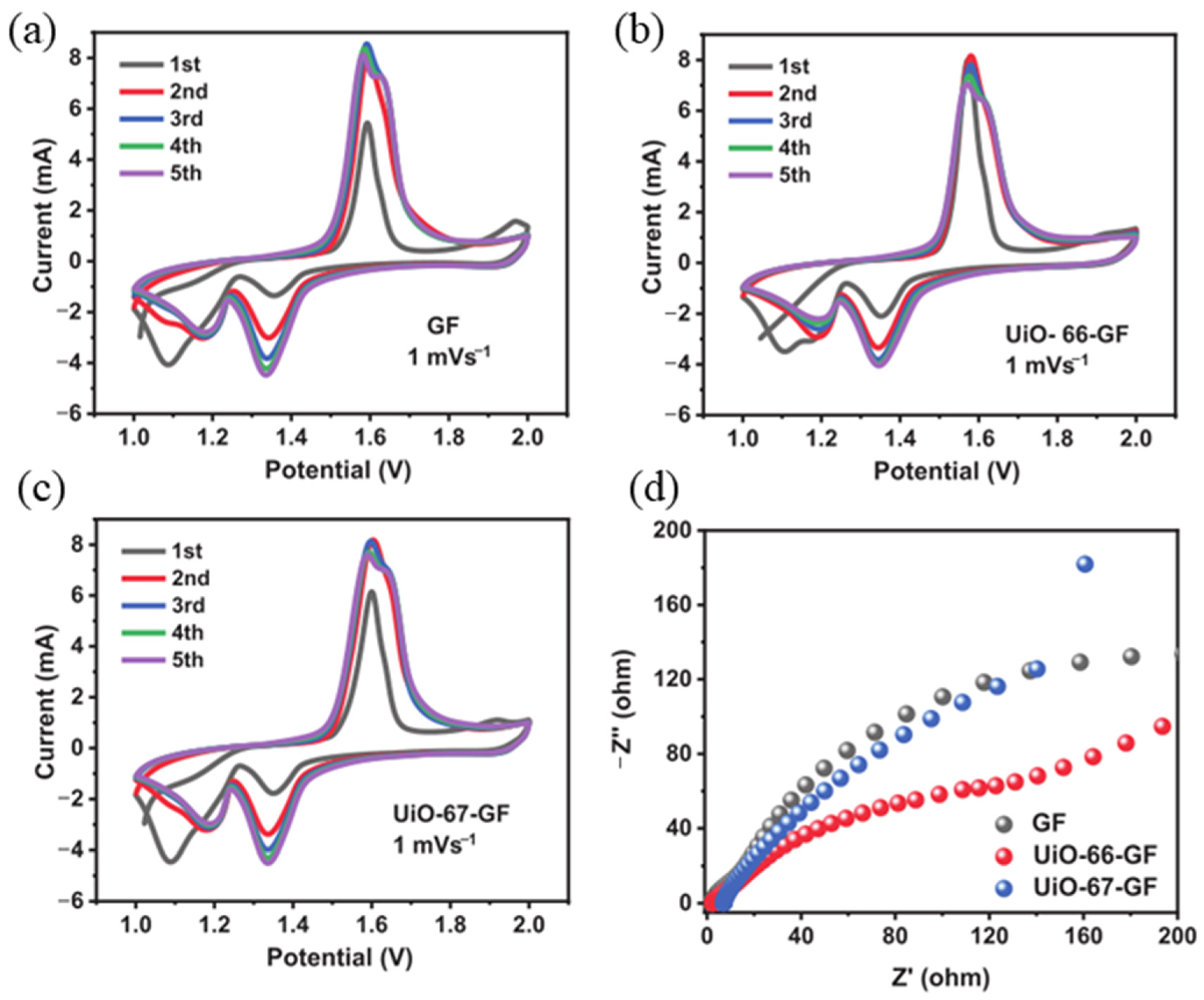
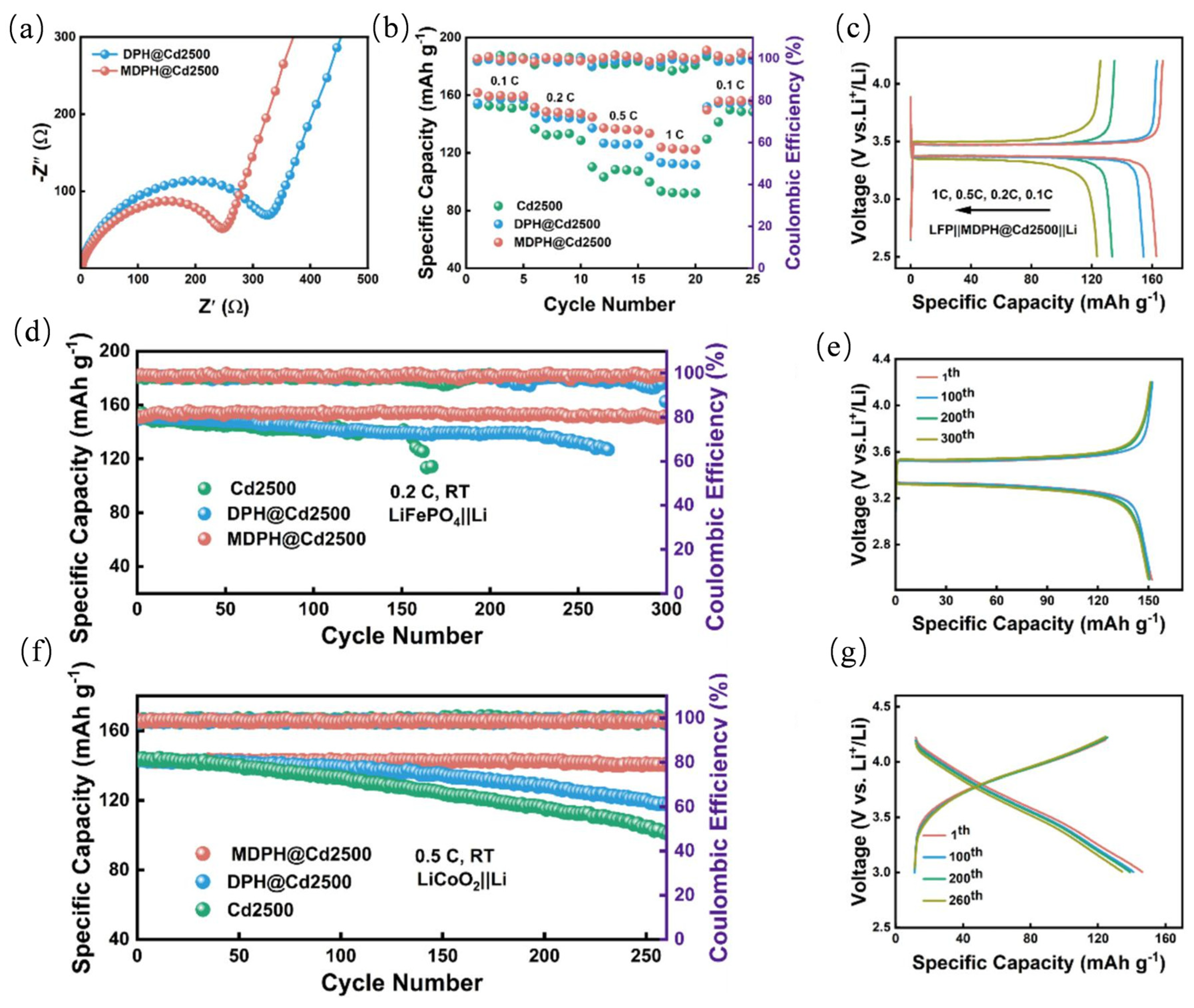

| Property | Pure MOF | MOF Composite | Functionalized MOF |
|---|---|---|---|
| Security | Extremely safe (intrinsically non-flammable) | Safe (MOF acts as flame-retardant filler) | Extremely safe (enhanced by functional groups) |
| Thermal stability | >400 °C | >200 °C | >400 °C |
| Thermal shrinkage | Negligible | Negligible | Negligible |
| Flame retardancy | Intrinsic | Significantly improved | Intrinsic (slightly affected by functional groups) |
| Ionic conductivity, | Medium–high (pore-structure-dependent) | High (MOF + polymer synergy) | Very high (functional groups or liquid media greatly promote ion transport) |
| Mechanical strength | Poor (brittle) | Excellent (polymer reinforced) | Medium (toughened by functionalization) |
| Electrolyte wettability | Excellent (high surface area) | Excellent (improves polyolefin hydrophobicity) | Outstanding (tunable hydrophilicity) |
| Dendrite suppression | Good (uniform pores) | Good–excellent (physical barrier) | Excellent (interface engineerable) |
| Cost | High (synthesis and film-forming difficult) | Medium (scalable) | High (functionalization adds cost) |
| Representative material | ZIF-8, UiO-66, etc. | ZIF-67@ PP/PE/PI, UiO-66P@PP/PE/PI, etc. | MOF functionalized with –NH2, –SO3H, etc. |
| Key Safety Issues | Critical Roles of MOF Separator | Major Challenges | |
|---|---|---|---|
| LIBs | Thermal runaway, Li dendrites, separator shrinkage. | Non-flammability, thermal stability, dendrite suppression. | Mechanical strength, long-term chemical stability. |
| Li-S | Polysulfide shuttle, volume expansion, side reactions. | Shuttle inhibition, enhanced sulfur utilization and cycle life. | Performance retention under high sulfur loading, Cost. |
| AZIBs | Zn dendrites, hydrogen evolution, by-product formation. | Guided Zn2+ deposition, suppression of dendrites and side reactions. | Stability in aqueous electrolytes, scalable fabrication. |
| SSLMBs | Poor interfacial contact, Li dendrites, low ionic conductivity. | Improved interfacial stability, dendrite suppression, enhanced ion transport. | Insufficient intrinsic ionic conductivity, high interfacial impedance. |
Disclaimer/Publisher’s Note: The statements, opinions and data contained in all publications are solely those of the individual author(s) and contributor(s) and not of MDPI and/or the editor(s). MDPI and/or the editor(s) disclaim responsibility for any injury to people or property resulting from any ideas, methods, instructions or products referred to in the content. |
© 2025 by the authors. Licensee MDPI, Basel, Switzerland. This article is an open access article distributed under the terms and conditions of the Creative Commons Attribution (CC BY) license (https://creativecommons.org/licenses/by/4.0/).
Share and Cite
Zhao, T.; Bi, Y.; Chen, J.; Yu, J.; Peng, S.; Luo, F.; Chen, Y. Progress in Improving Safety Performance of Battery Separators Based on MOF Materials: Mechanisms, Materials and Applications. Safety 2025, 11, 111. https://doi.org/10.3390/safety11040111
Zhao T, Bi Y, Chen J, Yu J, Peng S, Luo F, Chen Y. Progress in Improving Safety Performance of Battery Separators Based on MOF Materials: Mechanisms, Materials and Applications. Safety. 2025; 11(4):111. https://doi.org/10.3390/safety11040111
Chicago/Turabian StyleZhao, Tian, Yajuan Bi, Jiayao Chen, Jiangrong Yu, Shilin Peng, Fuli Luo, and Yi Chen. 2025. "Progress in Improving Safety Performance of Battery Separators Based on MOF Materials: Mechanisms, Materials and Applications" Safety 11, no. 4: 111. https://doi.org/10.3390/safety11040111
APA StyleZhao, T., Bi, Y., Chen, J., Yu, J., Peng, S., Luo, F., & Chen, Y. (2025). Progress in Improving Safety Performance of Battery Separators Based on MOF Materials: Mechanisms, Materials and Applications. Safety, 11(4), 111. https://doi.org/10.3390/safety11040111






